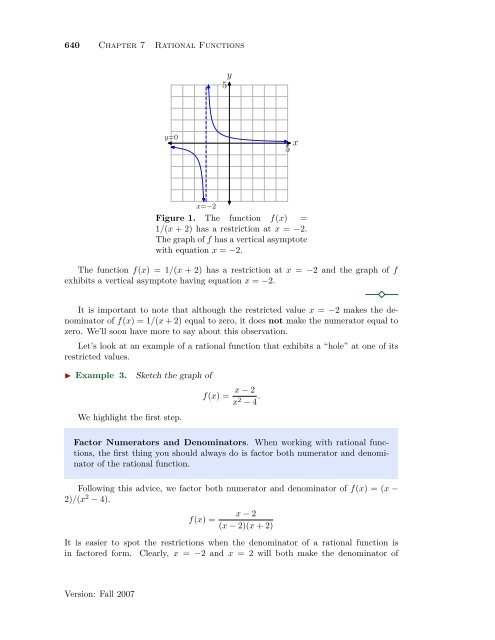Chapter 7 Rational Functions - College of the Redwoods
Chapter 7 Rational Functions - College of the Redwoods
Chapter 7 Rational Functions - College of the Redwoods
Create successful ePaper yourself
Turn your PDF publications into a flip-book with our unique Google optimized e-Paper software.
640 <strong>Chapter</strong> 7 <strong>Rational</strong> <strong>Functions</strong><br />
y<br />
5<br />
y=0<br />
x<br />
5<br />
x=−2<br />
Figure 1. The function f(x) =<br />
1/(x + 2) has a restriction at x = −2.<br />
The graph <strong>of</strong> f has a vertical asymptote<br />
with equation x = −2.<br />
The function f(x) = 1/(x + 2) has a restriction at x = −2 and <strong>the</strong> graph <strong>of</strong> f<br />
exhibits a vertical asymptote having equation x = −2.<br />
It is important to note that although <strong>the</strong> restricted value x = −2 makes <strong>the</strong> denominator<br />
<strong>of</strong> f(x) = 1/(x + 2) equal to zero, it does not make <strong>the</strong> numerator equal to<br />
zero. We’ll soon have more to say about this observation.<br />
Let’s look at an example <strong>of</strong> a rational function that exhibits a “hole” at one <strong>of</strong> its<br />
restricted values.<br />
◮ Example 3.<br />
Sketch <strong>the</strong> graph <strong>of</strong><br />
f(x) = x − 2<br />
x 2 − 4 .<br />
We highlight <strong>the</strong> first step.<br />
Factor Numerators and Denominators. When working with rational functions,<br />
<strong>the</strong> first thing you should always do is factor both numerator and denominator<br />
<strong>of</strong> <strong>the</strong> rational function.<br />
Following this advice, we factor both numerator and denominator <strong>of</strong> f(x) = (x −<br />
2)/(x 2 − 4).<br />
f(x) =<br />
x − 2<br />
(x − 2)(x + 2)<br />
It is easier to spot <strong>the</strong> restrictions when <strong>the</strong> denominator <strong>of</strong> a rational function is<br />
in factored form. Clearly, x = −2 and x = 2 will both make <strong>the</strong> denominator <strong>of</strong><br />
Version: Fall 2007

















